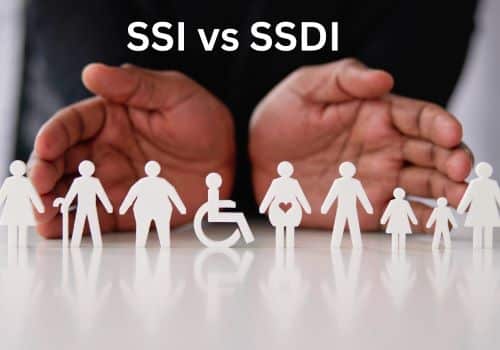If you are unable to work due to a disability, you might be looking for assistance programs in which you can enroll. In addition to disability benefits, some of these programs also provide benefits to low-income seniors and other individuals. Supplemental Security Income (SSI) benefits and Social Security Disability Insurance (SSDI) benefits are two of the most common programs you might hear about. There are some similarities between the two, but there are also some big differences.
The Social Security Administration (SSA) administers both of these critical Social Security benefit programs, but there are differences in eligibility criteria, payment amounts, and other details.
If you are considering applying for SSI or SSDI benefits, then keep reading. We will give you all the details on each program and tell you the big differences between the two.
What Is Supplemental Security Income (SSI)?
Supplemental Security Income is a federal program that provides financial assistance to low-income seniors and those who are unable to work due to a disability. To qualify for the program, you must have a financial need. A person’s income must be below certain limits, and the person must also have limited resources.
For example, someone with a large savings account at a bank could not qualify for SSI benefits. Payments associated with SSI are usually fairly small, although no work history is required to qualify for benefits.
Many states also supplement the SSI program with state-sponsored benefits. In addition, SSI recipients automatically qualify for many other assistance programs. SSI recipients might also receive food stamps, housing assistance, a government cell phone, Medicaid, and other benefits.
As part of the application process for SSI, you will need to provide evidence of your financial need. This evidence might be in the form of tax returns, bank statements, or other evidence showing your financial situation.
Many people wonder, “Is SSI the same as disability?” While you can get SSI because of a disability, SSI is not the same thing as Social Security disability insurance. SSDI will be discussed more in the next section.
KEY TAKEAWAYS
- If you qualify, SSDI benefits are generally higher than SSI benefits.
- In most cases, SSI benefits are easier to qualify for than SSDI benefits. You may be able to qualify for SSI without a disability, if you are age 65 or older and meet the financial needs requirements.
- There are some instances where you may be able to receive both SSDI and SSI benefits.
What Is Social Security Disability Insurance (SSDI)?
SSDI benefits are financial benefits paid to those who are unable to work due to a disability and who have enough work history to qualify for SSDI. No financial need is necessary to qualify for SSDI benefits, although SSDI recipients must have a sufficient work history to qualify for benefits.
In general, a person must work for ten years to earn enough work credits to qualify for SSDI. Monthly payment amounts are based on how much money the person earned while working.
The application process for Social Security disability benefits is quite lengthy in most cases. It is not uncommon for a person to wait two years from their application date before finally getting approved for disability benefits.
In many cases, an initial application might be denied, and the applicant may need to hire an attorney and appeal the decision to ultimately get approved for benefits. Once a person has received SSDI benefits for 24 months, they become eligible for health insurance through Medicare.
An eligible spouse or dependent child might also qualify for SSDI payments based on the work history of the primary earner.
Must read articles related to SSI and SSDI
- A complete guide on “How to Apply for SSI“.
- A complete guide on “How to Apply for SSDI“.
- Helping a family member with a disability, learn “How to get paid to take care of a family member with a disability“.
- Find out how much money you can receive while on SSI.
- Learn more about how to win SSI appeal or how to win an SSI overpayment case.
SSDI vs SSI Benefits: 5 Key Differences In Disability Benefits

Both of these federal benefit programs are administered by the Social Security Administration, and both programs provide financial assistance to those with disabilities.
So what is the difference between SSI and SDI? There are some major differences, and here are the biggest ones:
— Eligibility Criteria
One of the biggest differences between SSI and SSDI is the eligibility criteria. Qualifying for SSDI benefits requires that you have worked and paid Social Security taxes for a sufficient period of time to earn enough work credits. Generally, this means that you have worked and paid payroll taxes for at least ten years. You must also have an impairment that prevents you from performing a substantial gainful activity. The Social Security Administration has strict guidelines and definitions for the conditions that qualify as a disability. If you meet these two criteria, then you can get SSDI benefits.
SSI benefits, on the other hand, do not require a work history or earnings record. You can qualify for the SSI disability program even if you have never worked at all. However, you must have a financial need. Generally, you must earn less than $1,767 per month and have less than $2,000 in resources. In addition, SSI is not just for disabled people. You can also qualify for SSI benefits if you are blind or are age 65 or older.
— Application Process
The application process for SSI and SSDI is slightly different. One of the main differences here is the method in which the application is completed. You can apply for SSDI benefits online through a My Social Security account. You will be able to complete the entire SSDI application process online, although you can choose to visit your local Social Security office or complete the application over the phone.
For SSI benefits, you may start your application online. However, after providing some basic information, a Social Security representative will schedule an appointment for you to complete your application. You will need to provide evidence of your financial need during the application process.
— Benefit Amounts
There is also a big difference in the monthly benefit amount between the SSI program and the Social Security disability insurance program. SSI payments are typically much lower than SSDI payments. The maximum monthly SSI payment for an adult in 2024 is $943, while the average SSI payment is only about $670 per month. As you can see, SSI is meant to be more of a financial safety net than a way to earn money.
The maximum amount that you can receive on SSDI benefits is about $3,822 per month, but the average amount received by an SSDI beneficiary is about $1,537 per month. Roughly 90% of SSDI beneficiaries receive less than $2,000 per month. There is also a five-month waiting period for SSDI benefits. This means that you will not start receiving benefits until five months after the onset of your disability. There is no waiting period for SSI benefits.
— Length Of Benefits
The length of time you receive benefits can also differ between these two programs. Many people who receive federal SSI payments will receive them for the rest of their lives, especially those who are approved after age 65. Younger individuals can receive SSI benefits as long as they are disabled and continue to have financial need.
SSDI claimants, on the other hand, might switch over to Social Security retirement benefits upon reaching retirement age. Similarly, SSDI benefits stop once the recipient is no longer disabled. You might be required to provide evidence from your medical provider of a continued disability if you are subject to ongoing medical reviews.
— Healthcare Coverage
There is a major difference in the type of healthcare you will receive between these two programs. Most SSI recipients will qualify for Medicaid through their state’s Medicaid office. Medicaid is the health care program provided to low-income individuals and families, and participation in SSI will usually automatically qualify you for Medicaid.
On the other hand, SSDI beneficiaries become eligible for Medicare after receiving SSDI payments for 24 months. You might think that Medicare is only for retirees, but the program also covers disabled people who are receiving SSDI payments. SSDI recipients will generally be automatically enrolled in Medicare coverage after their 24th month in the SSDI program.
TIP
You can potentially recieve both SSDI and SSI if you have limited resources and if the SSDI benefit payments are below the SSI limits. You should consult a disability attorney to assist in this type of situation.
Can You Receive Both SSI and SSDI?
As you can see, there are some significant differences between the SSI and SSDI programs. But, can you get benefits from both? The answer is yes!
Here is how that can happen. Some people are approved for SSDI benefits, but their payments are very low. In that case, the person might also qualify for cash benefits from the SSI program as well if they have limited resources. So, if your monthly payments through SSDI are below the SSI limit and you also have limited resources, then you might qualify for payments through both programs.
You can always seek the help of an experienced disability attorney to help you navigate that complex situation.
The Bottom Line
U.S. citizens who are disabled and unable to work might apply for benefits through SSI or SSDI. Both benefit programs provide monthly payments to recipients and their eligible family members, but there are some big differences between the two programs.
- SSDI requires a sufficient work history, while SSI does not.
- SSI requires a financial need, while SSDI has no income limit.
- SSDI payments are usually much higher than SSI payments.
- SSDI payments are generally double SSI payment amounts, on average.
If you believe you might qualify for either program, you should contact the Social Security Administration to start your application.
Frequently Asked Questions
SSI is generally a needs-based program. Benefits are available to those who are U.S. citizens or qualifying aliens age 65 or older, with limited resources & income.
Other adults and children may qualify if they are blind or disabled and have limited income.
Individuals generally need to have less than $2,000 in resources and must have limited income.
SSDI benefits generally provide more income than SSI benefits. However, this depends on your earning history and how much you’ve paid into the system.
SSI benefits in general might be lower than SSDI. However, you don’t need a work history to qualify. If you have limited income and resources, then you may be eligible.
If you are disabled, you should seek out the program (or in some cases both) that will benefit you and your family the most.
There are different requirements for both programs. SSI is a needs-based program that has income and resource limitations to qualify.
To learn more about the SSI requirements, check out our article “What is SSI?“.
SSDI benefits are based on a work history that (in most cases) requires you to have contributed (through Social Security taxes) to the program for at least 10 years.
Learn more about what conditions qualify for disability by checking out our other resources.
SSI monthly payments are fairly low. In 2024, an individual may receive a maximum monthly benefit of $943, while a couple can only receive $1,415.
What is the average SSI monthly Payment? The average payment is about $670 per month.
These amounts are set by the Federal Benefit Rate. This is why it is often necessary for individuals receiving SSI benefits to get assistance from state programs that provide other financial help.
No, they are two very different programs. The main difference between SSI and SSDI is that SSDI benefits require a work history.
You must have paid Social Security taxes to qualify for SSDI. SSDI payments are typically higher than SSI payments, and there is no requirement that you have a financial need to qualify for SSDI payments.
Another difference is the fact that you can qualify for SSI benefits even if you don’t have a disability, as long as you are 65 or older and have limited income and resources.
Some people might attempt to collect both unemployment and Social Security disability; however, the eligibility requirements for those two programs are fundamentally at odds with each other.
You can find a Social Security Administration office near you by using our SSA office locator and searching for your closest location.





